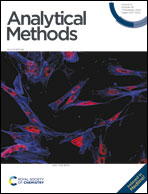Analysis of benzodiazepines by thermal desorption direct analysis in real time mass spectrometry (TD-DART-MS)†
Abstract
One of the several classes of novel psychoactive substances (NPSs) that present analytical challenges for forensic chemists is benzodiazepines. Like other NPS classes, the emergence of new compounds within this class continues, creating a need for the development of new techniques and methods that allow for rapid detection and identification of these compounds in forensics laboratories. This work investigates the use of thermal desorption direct analysis in real time mass spectrometry (TD-DART-MS) as a tool for the rapid and sensitive detection of benzodiazepines. A suite of 19 benzodiazepines were investigated to determine their representative responses. The limits of detection (LODs) for these compounds were found to range from 0.05 ng to 8 ng. Competitive ionization studies highlighted that the detection of these compounds in the presence of cutting agents and low amounts of heroin was possible. Additionally, the presence of three complex background matrices that are common in trace detection applications (artificial fingerprint residues, dirt, and plasticizers) was investigated and was shown to have a minimal effect on the detection of these compounds. TD-DART-MS was demonstrated as a potentially powerful tool for rapid on-site or laboratory-based screening.

- This article is part of the themed collection: Analytical Methods Recent HOT articles


 Please wait while we load your content...
Please wait while we load your content...